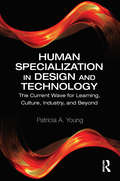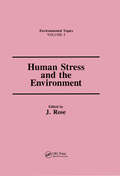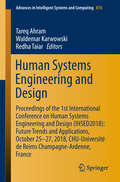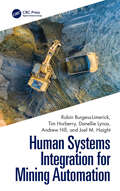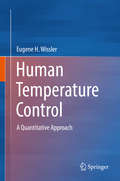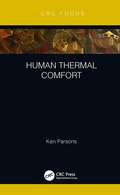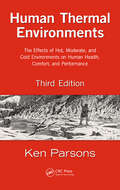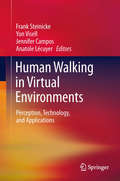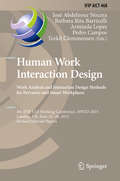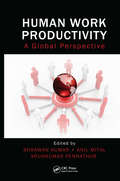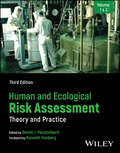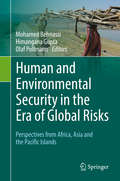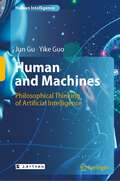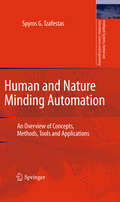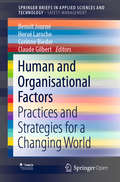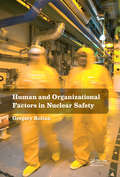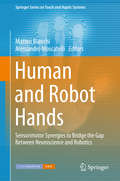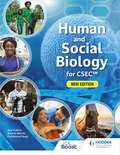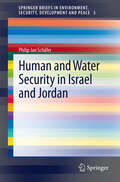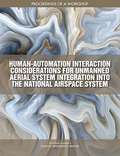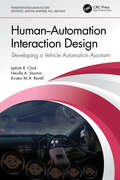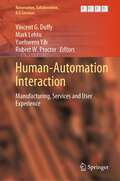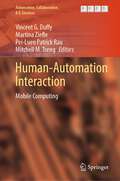- Table View
- List View
Human Specialization in Design and Technology: The Current Wave for Learning, Culture, Industry, and Beyond
by Patricia A. YoungHuman Specialization in Design and Technology explores emerging trends in learning and training—standardization, personalization, customization, and specialization—with a unique focus on innovations specific to human needs and conditions. Analyzing evidence from current academic research as well as the popular press, this concise volume defines and examines the trajectory of instructional design and technologies toward more human-centered and specialized products, services, processes, environments, and systems. Examples from education, healthcare, business, and other sectors offer real-world demonstrations for scholars and graduate students of educational technology, instructional design, and business development. The book features insights into the future of professors, public schools, equity and access, extended technologies, open educational resources, and more, concluding with a set of concrete solutions.
Human Stress and the Environment
by Allen H. RoseFirst published in 1994. This volume is devoted to a study of the relationship between stress and health. The aim of this work is to present an account of this complex and difficult problem, without the sensationalism often associated with modern environmental remedies.
Human Systems Engineering and Design II: Proceedings of the 2nd International Conference on Human Systems Engineering and Design (IHSED2019): Future Trends and Applications, September 16-18, 2019, Universität der Bundeswehr München, Munich, Germany (Advances in Intelligent Systems and Computing #1026)
by Stefan Pickl Waldemar Karwowski Tareq Ahram Redha TaiarThis book focuses on novel design and systems engineering approaches, including theories and best practices, for promoting a better integration of people and engineering systems. It covers a range of hot topics related to: development of human-centered systems; interface design and human-computer interaction; usability and user experience; emergent properties of human behavior; innovative materials in manufacturing, biomechanics, and sports medicine, safety engineering and systems complexity business analytics, design and technology and many more. The book, which gathers selected papers presented at the 2nd International Conference on Human Systems Engineering and Design: Future Trends and Applications (IHSED 2019), held on September 16-18, 2019, at Universität der Bundeswehr München, Munich, Germany, provides researchers, practitioners and program managers with a snapshot of the state-of-the-art and current challenges in the field of human systems engineering and design.
Human Systems Engineering and Design: Proceedings of the 1st International Conference on Human Systems Engineering and Design (IHSED2018): Future Trends and Applications, October 25-27, 2018, CHU-Université de Reims Champagne-Ardenne, France (Advances in Intelligent Systems and Computing #876)
by Waldemar Karwowski Tareq Ahram Redha TaiarThis book focuses on novel design and systems engineering approaches, including theories and best practices, for promoting a better integration of people and engineering systems. It covers a range of hot topics related to: development of activity-centered and user-centered systems; interface design and human-computer interaction; usability and user experience; cooperative, participatory and contextual models; emergent properties of human behavior; innovative materials in manufacturing, and many more. Particular emphasis is placed on applications in sports, healthcare, and medicine. The book, which gathers selected papers presented at the 1st International Conference on Human Systems Engineering and Design: Future Trends and Applications (IHSED 2018), held on October 25-27, 2018, at CHU-Université de Reims Champagne-Ardenne, France, provides researchers, practitioners and program managers with a snapshot of the state-of-the-art and current challenges in the field of human systems engineering and design.
Human Systems Integration for Mining Automation
by Tim Horberry Robin Burgess-Limerick Danellie Lynas Andrew Hill Joel M HaightHuman Systems Integration for Mining Automation is the professional’s guide to understanding the issues, approaches, and pitfalls associated with mining automation from a human perspective. This book delves into a timely and fast-developing issue in mining and the wider minerals industry - the design and deployment of automation. The book approaches this from a “Human Systems Integration” standpoint in which the technical and human-related aspects are jointly considered as part of an integrated, automated mining system. This accessible and readable title offers a wider Human Systems Integration framework that can be applied to mining projects. It is based on an established framework that has been developed and used successfully in other work. The framework is backed up with information obtained from mines in Australia, the USA, Canada, Sweden, and Chile and original equipment manufacturers such as Caterpillar, Komatsu, Sandvik and Epiroc. Every reader of this book will recognise the essential benefits of human systems integration for mining automation.This book will be an ideal read for industry professionals including systems engineers, safety engineers, mining engineers, human factors engineers, and engineers working on developing and deploying automation in mining and related industries including rail, road transport, and process control. It will also be of interest to students, researchers, and academics in related fields.
Human Temperature Control: A Quantitative Approach
by Eugene H. WisslerThe principal objective of this book is to provide information needed to define human thermal behavior quantitatively. Human thermal physiology is defined using mathematical methods routinely employed by physicists and engineers, but seldom used by physiologists. Major sections of the book are devoted to blood flow, sweating, shivering, heat transfer within the body, and heat and mass transfer from skin and clothing to the environment. Simple algebraic models based on experimental data from a century of physiological investigation are developed for bodily processes. The book offers an invaluable source of information for physiologists and physical scientists interested in quantitative approaches to the fascinating field of human thermoregulation.
Human Thermal Comfort
by Ken ParsonsThermal comfort is a desirable state familiar to all people. Providing inspirational indoor and outdoor environments that provide thermal comfort, in the context of energy use and climate change, is a challenge for the 21st century. This book provides an up-to-date, comprehensive coverage of thermal comfort from principles and theory to practical application. The book begins with current knowledge and understanding of thermal comfort and its application to providing thermal conditions for indoor and outdoor environments. It integrates and presents new ideas to provide a comprehensive model of thermal comfort so that we can move on from the 20th and early 21st century and provide a focus for developments for future decades. This book will be of interest to practitioners and students and anyone involved with fields such as environmental design, physiology, ergonomics, human factors, industrial hygiene, architecture, health and safety and air conditioning. • Provides current thermal comfort standards and regulations • Describes the PMV, PPD, ET* and SET thermal comfort indices • Discusses adaptive thermal comfort, adaptive opportunity and explains why we have not moved towards a more dynamic and interactive approach to providing thermal comfort • Presents a new model relating thermal discomfort to performance • Shows how to construct a computer model of thermal comfort • Offers how to conduct a thermal comfort survey Human Thermal Comfort provides new ideas for achieving thermal comfort for offices, vehicles, atriums, and plazas of the future.
Human Thermal Environments: The Effects of Hot, Moderate, and Cold Environments on Human Health, Comfort, and Performance, Third Edition
by Ken ParsonsIn the ten years since the publication of the second edition of Human Thermal Environments: The Effects of Hot, Moderate, and Cold Environments on Human Health, Comfort, and Performance, Third Edition, the world has embraced electronic communications, making international collaboration almost instantaneous and global. However, there is still a need
Human Walking in Virtual Environments: Perception, Technology, and Applications
by Anatole Lécuyer Frank Steinicke Jennifer Campos Yon VisellThis book presents a survey of past and recent developments on human walking in virtual environments with an emphasis on human self-motion perception, the multisensory nature of experiences of walking, conceptual design approaches, current technologies, and applications. The use of Virtual Reality and movement simulation systems is becoming increasingly popular and more accessible to a wide variety of research fields and applications. While, in the past, simulation technologies have focused on developing realistic, interactive visual environments, it is becoming increasingly obvious that our everyday interactions are highly multisensory. Therefore, investigators are beginning to understand the critical importance of developing and validating locomotor interfaces that can allow for realistic, natural behaviours. The book aims to present an overview of what is currently understood about human perception and performance when moving in virtual environments and to situate it relative to the broader scientific and engineering literature on human locomotion and locomotion interfaces. The contents include scientific background and recent empirical findings related to biomechanics, self-motion perception, and physical interactions. The book also discusses conceptual approaches to multimodal sensing, display systems, and interaction for walking in real and virtual environments. Finally, it will present current and emerging applications in areas such as gait and posture rehabilitation, gaming, sports, and architectural design.
Human Work Interaction Design. Work Analysis and Interaction Design Methods for Pervasive and Smart Workplaces
by José Abdelnour Nocera Barbara Rita Barricelli Arminda Lopes Pedro Campos Torkil ClemmensenThis book constitutes the thoroughly refereed post-conference proceedings of the 4th IFIP WG 13. 6 Working Conference on Human Work Interaction Design, HWID 2015, held in London, UK, in June 2015. The 15 revised full papers presented were carefully selected for inclusion in this volume. The papers reflect many different areas and address many complex and diverse work domains, focusing on the integration of work analysis and interaction design methods for pervasive and smart workplaces. They are organized in the following sections: methodologies; environment, and specific contexts.
Human Work Productivity: A Global Perspective
by Arunkumar Pennathur Anil Mital Shrawan KumarThe current global economic downturn and considerable shifting in industrial and manufacturing activities have disturbed the industrial order. However, human work productivity is still one of the most important components of the industrial economy and a determining factor in global competiveness and influence as well as the potential for technologi
Human and Ecological Risk Assessment: Theory and Practice - Set
by Dennis J. PaustenbachUnderstand the fundamentals of human risk assessment with this introduction and reference Human risk assessments are a precondition for virtually all industrial action or environmental regulation, all the more essential in a world where chemical and environmental hazards are becoming more abundant. These documents catalog potential environmental, toxicological, ecological, or other harms resulting from a particular hazard, from chemical spills to construction projects to dangerous workplaces. They turn on a number of variables, of which the most significant is the degree of human exposure to the hazardous agent or process. Human and Ecological Risk Assessment combines the virtues of a textbook and reference work to introduce and analyze these vital documents. Beginning with the foundational theory of human health risk assessment, it then supplies case studies and detailed analysis illustrating the practice of producing risk assessment documents. Fully updated and authored by leading authorities in the field, the result is an indispensable work. Readers of the second edition of Human and Ecological Risk Assessment will also find: Over 40 entirely new case studies reflecting the latest in risk assessment practice Detailed discussion of hazards including air emissions, contaminated food and soil, hazardous waste sites, and many more Case studies from multiple countries to reflect diverse international standards Human and Ecological Risk Assessment is ideal for professionals and advanced graduate students in toxicology, industrial hygiene, occupational medicine, environmental science, and all related subjects.
Human and Environmental Security in the Era of Global Risks: Perspectives from Africa, Asia and the Pacific Islands
by Mohamed Behnassi Olaf Pollmann Himangana GuptaThis book discusses ways to deepen the debate on the linkages between global risks and human and environmental security. The approach put forward in this book is one of questioning the ability of existing concepts, regulatory frameworks, technologies and decision-making mechanisms to accurately deal with emerging risks to human and environmental security, and to act in the direction of effectively managing their impacts and fostering the resilience of concerned systems and resources. Empirical research findings from Africa, Asia and the Pacific Islands are provided.During the last decades the links between emerging risks and the security of humans and nature have been the object of considerable research and deliberations. However, it is only recently becoming an important focus of policy making and advocacy. In this contributed volume, it is presumed that the ability – or lack thereof – to make innovative conceptual frameworks, institutional and policy arrangements, and technological advances for managing the current emerging risks, will foster or undermine the environmental security, and consequently determine the future human security. Moreover, taking into account the links between environmental/climate security, human security and sustainability will help frame a new research agenda and potentially develop a broad range of responses to many delicate questions.
Human and Machines: Philosophical Thinking of Artificial Intelligence (Human Intelligence)
by Yike Guo Jun GuThis book shares Chinese scholars’ philosophical views on artificial intelligence. The discussions range from the foundations of AI—the Turing test and creation of machine intelligence—to recent applications of AI, including decisions in games, natural languages, pattern recognition, prediction in economic contexts, autonomous behaviors, and collaborative intelligence, with the examples of AlphaGo, Microsoft’s Xiao Bing, medical robots, etc. The book’s closing chapter focuses on Chinese machines and explores questions on the cultural background of artificial intelligence. Given its scope, the book offers a valuable resource for all members of the general public who are interested in the future development of artificial intelligence, especially from the perspective of respected Chinese scholars.
Human and Nature Minding Automation
by Spyros G. TzafestasThis book examines the "symbiosis" of automation and technology with the human and the nature towards the ultimate goal of assuring global sustainability. Throughout the years a variety of approaches, technologies and practices have been produced in the direction of achieving human-and nature-minding automation and industrial activity. In this book an attempt is made, for the first time, to present in a cohesive and consolidated way an overview of all these issues together, and show how they combine to provide human-and nature-minding (green) systems. Human-minding automation is possible by employing concepts and techniques from the human factors and ergonomics fields, including job satisfaction, human-friendly interfaces, and human values, whereas nature-minding industrial activity and human development can be achieved by considering as a whole the human, economic, natural and cultural resources in the short and long term. In particular, nature-minding design selects the production methods and technologies that have the minimum impact to the nature. The book is intended for use both as a free reference conceptual book, and as general introductory book in relevant teaching and research environments.
Human and Organisational Factors: Practices and Strategies for a Changing World (SpringerBriefs in Applied Sciences and Technology)
by Corinne Bieder Claude Gilbert Benoît Journé Hervé LarocheThis open access book addresses several questions regarding the implementation of human and organisational factors (HOF) so that recent improvements in industrial safety can be built upon. It addresses sources of frustration in senior management with high expectations of operational recommendations and disquiet on the part of HOF specialists struggling to have an impact on high-level decision making. The brief explores these issues with an emphasis on examples and lessons learned based on the experience of its authors, who come from different academic disciplines and various industrial sectors such as oil and gas, energy and transportation. It then offers some ways forward for a better consideration of HOF in hazardous companies with a view of promoting safety and facing challenges in a rapidly changing world.
Human and Organizational Factors in Nuclear Safety: The French Approach to Safety Assessments
by Gregory RolinaThis book discusses the specifics of safety regulations regarding nuclear risk and the safety of nuclear installations. The author shows that (French) regulations concerning nuclear safety depend on maintaining a technical dialogue between the ASN, IRSN and nuclear operators. In the face of an ongoing European and global re-evaluation of the safety of nuclear power and alignment towards the Anglo-Saxon standard, the French approach may yet be able to make a significant contribution. This work will be of interest to all involved in nuclear power engineering and in the field of risk management and nuclear safety.
Human and Robot Hands
by Matteo Bianchi Alessandro MoscatelliThis booklooks at the common problems both human and robotic hands encounter when controllingthe large number of joints, actuators and sensors required to efficientlyperform motor tasks such as object exploration, manipulation and grasping. The authorsadopt an integrated approach to explore the control of the hand based onsensorimotor synergies that can be applied in both neuroscience androbotics. Hand synergies are based on goal-directed, combined muscle andkinematic activation leading to a reduction of the dimensionality of the motorand sensory space, presenting a highly effective solution for the fast and simplifieddesign of artificial systems. Presented intwo parts, the first part, Neuroscience, provides the theoretical andexperimental foundations to describe the synergistic organization of the humanhand. The second part, Robotics, Models and Sensing Tools, exploits theframework of hand synergies to better control and design robotic hands andhaptic/sensing systems/tools, using a reduced number of control inputs/sensors,with the goal of pushing their effectiveness close to the natural one. Human andRobot Hands provides a valuable reference for students, researchers anddesigners who are interested in the study and design of the artificial hand.
Human and Social Biology for CSEC
by Ann FullickProvide a comprehensive and engaging student-centred approach to Human and Social Biology with an updated textbook aligned to the latest CSEC syllabus for examination from June 2022. - Cover all topics with brand new content on the environment, diseases and pandemics with a full focus on their impact in the Caribbean - Develop subject knowledge with 'Did you know?' features; and consolidate learning using objectives, end of section checkpoint questions and summaries within each chapter- Create meaningful links with 'The Biologist's Toolkit' feature to strengthen maths, science and language skills needed to meet the course objectives- Support application of practical tasks via step-by-step guidance on how to research, present and analyse data, and come to realistic conclusions and recommendations - Avoid common errors with an increased focus on 'What the Examiners say' for problem topicsAdded for the eBook- Aid visual learning using diagrams, illustrations, video links and demonstrations in the eBook
Human and Social Biology for CSEC
by Ann FullickProvide a comprehensive and engaging student-centred approach to Human and Social Biology with an updated textbook aligned to the latest CSEC syllabus for examination from June 2022. - Cover all topics with brand new content on the environment, diseases and pandemics with a full focus on their impact in the Caribbean - Develop subject knowledge with 'Did you know?' features; and consolidate learning using objectives, end of section checkpoint questions and summaries within each chapter- Create meaningful links with 'The Biologist's Toolkit' feature to strengthen maths, science and language skills needed to meet the course objectives- Support application of practical tasks via step-by-step guidance on how to research, present and analyse data, and come to realistic conclusions and recommendations - Avoid common errors with an increased focus on 'What the Examiners say' for problem topicsAdded for the eBook- Aid visual learning using diagrams, illustrations, video links and demonstrations in the eBook
Human and Water Security in Israel and Jordan
by Philip Jan SchäferThe work aims at answering the question as to how far discourses on human security are present in Jordan and Israel, if they converge and if political solutions for the issue of water security could be derived. The analysis is based on the assumption that from human security perspective common solutions for urgent problems can be derived more easily than out of a perspective of national security. Yet it is acknowledged that according to a new security perspective different security threats are being identified by relevant actors. An empirical analysis of written statements and utterances of the respective security elites establishes the methodological tool for the identification of human security discourses in Israel and Jordan. Subsequently it is estimated how far water is presented as a matter of national security in Israel and Jordan using the theory of securitization.
Human-Automation Interaction Considerations for Unmanned Aerial System Integration into the National Airspace System: Proceedings Of A Workshop
by Engineering Medicine National Academies of SciencesPrior to 2012, unmanned aircraft systems (UAS) technology had been primarily used by the military and hobbyists, but it has more recently transitioned to broader application, including commercial and scientific applications, as well as to expanded military use. These new uses encroach on existing structures for managing the nation’s airspace and present significant challenges to ensure that UASs are coordinated safely and suitably with existing manned aircraft and air traffic management systems, particularly with the National Airspace System (NAS). Of particular concern is the interaction between human pilots, operators, or controllers and increasingly automated systems. Enhanced understanding of these interactions is essential to avoid unintended consequences, especially as new technologies emerge. In order to explore these issues, the National Academies of Sciences, Engineering, and Medicine organized a 2-day workshop in January 2018. This publication summarizes the presentations and discussions from the workshop.
Human-Automation Interaction Design: Developing a Vehicle Automation Assistant (Transportation Human Factors)
by Neville A. Stanton Jediah R. Clark Kirsten RevellThis text presents a four-step approach for applying communicative concepts to driving automation, including: scoping, piloting, designing, and testing. It further provides experimental data on how practical human-human communication strategies can be applied to interaction in automated vehicles. The book explores the role of communication and the nature of situation awareness in automated vehicles to ensure safe and usable automated vehicle operation. It covers the issue of interaction in automated vehicles by providing insight into communicative concepts, the transfer of control in human-teams, and how these concepts can be applied in automated vehicles. The theoretical framework is built on by presenting experimental findings, design workshop output and providing a demonstration of prototype generation for automated assistants that addresses a wide range of performance outcomes within human-machine interaction. Aimed at professionals, graduate students, and academic researchers in the fields of ergonomics, automotive engineering, transportation engineering, and human factors, this text: Discusses experimental findings on how practical human-human communication strategies can be applied to interaction in automated vehicles. Provides a four-step approach for applying communicative concepts to driving automation, including: scoping, piloting, designing and testing. Explores the role of distributed situation awareness in automated vehicles. Covers communication and system awareness in response to multiple complex road scenarios. Provides design guidelines for automation-human handover design.
Human-Automation Interaction: Manufacturing, Services and User Experience (Automation, Collaboration, & E-Services #10)
by Robert W. Proctor Vincent G. Duffy Yuehwern Yih Mark LehtoThis book provides practical guidance and awareness for a growing body of knowledge developing across a variety of disciplines and many countries. This book is a celebration of the Gavriel Salvendy International Symposium (GSIS) and provides a survey of topics and emerging areas of interest in human–automation interaction. This book for the GSIS emphasizes main thematic areas: manufacturing, services and user experience. Main areas of coverage include Section A: Advanced Production Management and Production Control; Section B: Healthcare Automation; Section C: Measuring and Modeling Human Performance; Section D: Usability and User Experience; Section E: Safety Management and Occupational Ergonomics; Section F: Manufacturing and Services; Section G: Data and Probabilistic Information; Section H: Training and Collaboration Technologies. Contributions from especially early career researchers were featured as part of this (virtual) symposium and celebration. Gavriel Salvendy initiated the conferences that run annually as Human–Computer Interaction International and Applied Human Factors and Ergonomics International (AHFE), both within the Lecture Notes in Springer. The book is inclusive of human–computer interaction and human factors and ergonomics principles, yet it is intended to serve a much wider audience that has interest in automation and human modeling. The emerging need for human–automation interaction expertise has developed from an ever-growing availability and presence of automation in our everyday lives.
Human-Automation Interaction: Mobile Computing (Automation, Collaboration, & E-Services #12)
by Martina Ziefle Vincent G. Duffy Pei-Luen Patrick Rau Mitchell M. TsengThis book provides practical guidance and awareness for a growing body of knowledge developing across a variety of disciplines. This initiative is a celebration of the Gavriel Salvendy International Symposium (GSIS) and provides a survey of topics and emerging areas of interest in human–automation interaction. This set of articles for the GSIS emphasizes a main thematic areas: mobile computing. Main areas of coverage include Section A: Health, Care and Assistive Technologies; Section B: Usability, User Experience and Design; Section C: Virtual Learning, Training and Collaboration; Section D: Ergonomics in Work, Automation and Production. In total, there are more than 600 pages emphasizing contributions from especially early career researchers that were featured as part of this (virtual) symposium and celebration. Gavriel Salvendy initiated the conferences that run annually as Human–Computer Interaction within LNCS of Springer and Applied Human Factors and Ergonomics International (AHFE). The book is inclusive of human–computer interaction and human factors and ergonomics principles, yet is intended to serve a much wider audience that has interest in automation and human modeling. The emerging need for human–automation interaction expertise has developed from an ever-growing availability and presence of automation in our everyday lives. This initiative is intended to provide practical guidance and awareness for a growing body of knowledge developing across a variety of disciplines and many countries.
